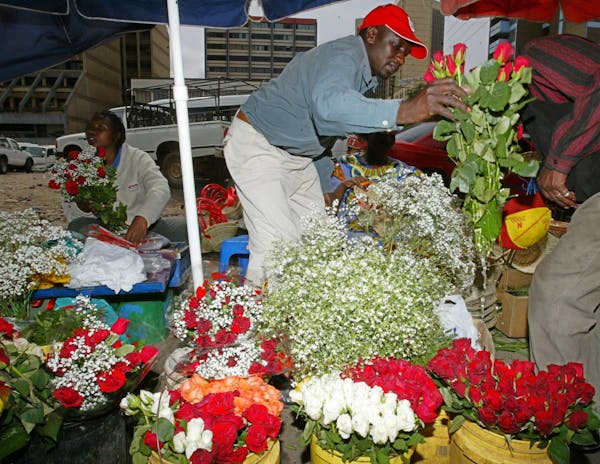Patrick Busch can start to rest today, and, well, maybe smell the roses.
For the past week, he and his employees at Len Busch Roses in Plymouth have labored 60 to 80 hours, harvesting, bundling and shipping roses to more than 800 florists and supermarkets in the Upper Midwest.
The last of the bouquets will get shipped out today, ensuring that hopeless romantics and henpecked partners can deliver the freshest of buds to their beloveds Feb. 14.
"We pull in all of our maintenance and office staff and pretty much anybody we can find to get us through this crunch," said Busch, 44, who bought the company from his father, Len, in 2000.
Nearly 15 percent of the company's $20 million in annual sales comes from Valentine's Day. It's a healthy percentage at a time when the bloom has fallen from the once-vaunted rose.
Growers in Colombia and Ecuador now dominate the U.S. market. Profit margins for roses are particularly tight, falling to less than half that of other cut flowers.
To stay afloat, Len Busch Roses has expanded its offering of higher-margin cut flowers and potted plants, including Gerbera daisies, alstroemeria, begonias and carnations. The company now also imports about 60 percent of what it distributes, mainly from Colombia, Ecuador and the Netherlands.
"When we first got into roses in the early 1970s, 80 percent of roses were produced domestically," Busch said. "We're down to 10 or 15 percent domestically now."
Outside of California, which has about 15 to 20 rose farms, Len Busch Roses is the only other rose grower in the country. Begun in 1965 with 28,000 square feet and a crop of pom poms, the company now has a half-million square feet of greenhouses and 160 full-time workers. This year, the company will produce about 2.5 million roses in 35 varieties, including the bright pink Orlando, Velvet Merlot red, Avalanche white and Moonlight yellow.
In 1979, rose imports represented a little more than 7 percent of domestic production, according to the United States Department of Agriculture. Back then, Indiana, Ohio, Pennsylvania, Colorado and New York also harvested healthy rose crops, and Minnesota had a handful of growers, including J.R. Johnson, Hermes Floral and Minneapolis Floral.
But by 1993, imports had increased to 87 percent of the rose market, and the South American crops easily undercut prices on home-grown varieties.
Today, a typical flower farm in Colombia covers 50 to 200 acres, compared to his 15 acres, Busch said. His greenhouse costs about $25 a square foot, compared to about $1 in the warmer climes of South America. With Busch paying his workers up to $15 an hour, his labor costs are six to eight times higher than those of competitors in Colombia and Ecuador, where workers earn about $300 a month, he said.
When you relate that to a single alstroemeria flower, Busch said its costs about 90 cents a stem for a homegrown plant compared to 40 cents a stem for the imported one.
Len Busch Roses handles more than 2,000 items for local florists, and replenishes the stock three times a week. Just 3 percent of the flowers are unable to be sold because they're spoiled or damaged by pests, he said.
"To do all that and not run out and not throw a lot away, it's like walking the high-wire," said Busch.
Green greenhouses
The company is not certified organic, but Busch said he's doing his part to be green. He uses four kinds of friendly pests to try to keep a lid on the destructive spider mite, and he uses a closed irrigation system to avoid wasting water.
This year, all his greenhouses are heated using biofuels -- tree trimmings that fire a couple of 400-horsepower boilers and create enough steam to heat the greenhouses to a comfortable 72 percent with high humidity.
Founder Len Busch installed the first boiler in the late 1970s, when energy prices were soaring. Patrick Busch added a second one last year, and expects to have it paid off in five years.
It's meant real money. So far this winter, Busch said he's paid $124 for natural gas. Without the biofuels, Busch estimates his heating bill would be north of $700,000.
"It feels really good because I don't hear the gas meter running," Busch said last week, on a day when temperatures hovered in the single digits.
Although people still buy flowers because folks are getting married, dying and getting sick, flowers remain for many the ultimate disposable income purchase.
Busch's business has not been untouched by the economic slowdown. Still, he's aiming for 6 percent growth in sales this year, believing that as people nest and spend more time at home than at restaurants and movies they'll want the comfort and color of flowers.
"We're seeing the beginnings of stronger demand and we think that's going to continue," Busch said.
Then again, there's always a flower-friendly holiday down the road. Easter, Mother's Day, Prom Night ....
To find local florists served by Len Busch Roses, go to www.lenbuschroses.com.
Jackie Crosby • 612-673-7335
Olympian Kristi Yamaguchi is 'tickled pink' to inspire a Barbie doll
A conservative quest to limit diversity programs gains momentum in states
New Jersey is motivating telecommuters to appeal their New York tax bills. Connecticut may be next
US banning TikTok? Your key questions answered

